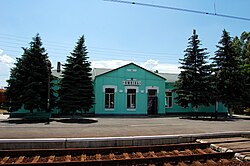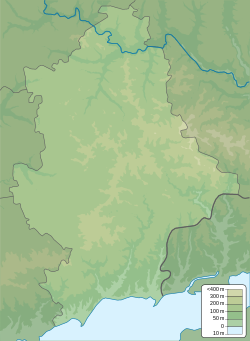Yampil (Ukrainian: Ямпіль; Russian: Ямполь) is a rural settlement in Lyman urban hromada, Kramatorsk Raion,[1] Donetsk Oblast, eastern Ukraine. It is located to the southeast of Lyman, lying north of local road T05-13. Previously, it was administered as part of Lyman Raion. It is also home to Yampil railway station.[2]
Yampil
Ямпіль | |
|---|---|
 Yampil Railstation | |
| Coordinates: 48°55′56″N 37°56′33″E / 48.93222°N 37.94250°E | |
| Country | |
| Oblast | |
| Raion | |
| Hromada | Lyman urban hromada |
| First documented | 1665 |
| Urban settlement status | 1938 |
| Area | |
• Total | 3.87 km2 (1.49 sq mi) |
| Elevation | 73 m (240 ft) |
| Population (2022) | |
• Total | 1,902 |
| Website | https://yampol-city.at.ua |

Wikimedia Commons has media related to Yampil. | |
History
editYampil's history is documented as early as 1665.[3] Historical records indicate that the lands of present-day Yampil belonged to the Sviatohirsk Lavra monastery, which was established under the protection of the settlements of Sukhariv, Repin Yurt, and Khrestovskyi (Raihorodok). These lands later came under the control of the Torsk and Mayak Cossacks.
A survey conducted in 1703 identified 117 Cossack yards associated with the Izyum Cossack Regiment in Yampil. During this period, a chapel and a prayer house were constructed in the village. It is also likely that Pavlo Ruban served as the village head at that time.
In 1712, Yampil was designated as an outpost for Russian imperial dragoons tasked with guarding the Torsk Bakhmut salt works.
In 1718, the village faced a devastating plague outbreak. The inhabitants, led by Yampil's priest Maxim, reached out to the monks of the Sviatohirsk Lavra for assistance. During the 1720s, severe flooding from the Donets caused significant damage, prompting the village to relocate to higher ground nearby. By 1729, this new settlement was referred to as "Old Village," as it was situated near where the Repin Yurt monastery had once stood.
In 1729, a fortress was constructed in Yampil, complete with a powder cellar and cannons. However, during Catherine II's reign, this fortress was dismantled. When Emperor Alexander I ascended to the throne in 1801, all military equipment, including cannons, was removed from Yampil.
After the abolition of the Slobid Cossack regiments in 1765 and the establishment of the Kharkov Governorate, Yampil became part of the Izyumsky Uyezd within this province.
The village narrowly escaped a cholera outbreak in 1831, which claimed only five lives. However, in 1833, a significant bread crop failure led to famine among residents. Cholera returned in 1847 and 1848, resulting in 26 deaths. In 1848, cattle disease devastated local farms, and scurvy also affected Yampil in 1849, causing five deaths among non-locals.
In 1938, Yampil was officially classified as an urban-type settlement.[4]
Russo-Ukrainian War
On June 19, 2014, the Armed Forces of Ukraine reportedly secured the settlement from pro-Russian separatists during the war in Donbas.[5]
On April 28, 2022 the town was occupied by Russia as part of its invasion of Ukraine during the battle of Donbas. On September 30, the town was liberated by the 214 Separate Rifle Battalion of the SOF and 103rd Territorial Defense Brigade.[6][7]
The town succumbed heavy shelling by the Russian forces, even after the town was liberated, with apparently not a single building left undamaged. As a result several inhabitants got killed and wounded. As of 2024 the town still is subjected to shelling by the Russians.[8][9][10][11]
Demographics
editAccording to the census of 1762, there were 350 male residents in the village.
In 1750, there were 450 men and 405 women.
In 1790, there were 1,364 men and 1,475 women.
In 1810, there were 1710 men and 1733 women.
In 1830, there were 1,090 men and 1,200 women.
In 1850, there were 1170 men and 1248 women.
In 1970, there were 3100 inhabitants.
In 2001, there were 2,302 residents.
Language
editDistribution of the population by native language according to 2001 Ukrainian census:[12]
| Language | Number | Percentage |
|---|---|---|
| Ukrainian | 2083 | 90.49% |
| Russian | 213 | 9.24% |
| Belarusian | 2 | 0.09% |
| Romanian | 2 | 0.09% |
| others/not specified | 2 | 0.09% |
| Total | 2302 | 100% |
Culture
editReligion
editIn 1704, it is indicated that there was a chapel and a prayer house in the village. It is not known whether there was a church in the Turnip yurt (where the village was later moved), but as noted by Philaret Gumilevsky, most likely there was a chapel there.
In 1718, the village already had its own priest named Maxim.
By order of 1724 year, it was allowed to build the Mykolaiv Church in Yampil. It is unknown whether there was a church in the village before that, or whether the parishioners were content with a chapel with a priest.
In 1725, Yampil already had its own, Mykolaiv Church, whose priest was ordained, at the request of the parishioners, Athanasius Pavlov (in 1744 he transferred to the Khotmyzhsk monastery.
In 1731, as a result of the request of sotnik Stepan Gukovsky with the foreman, and priest Athanasius Pavlov, it was allowed to move the Polish Mykolaiv Church to a new place, in the "Old Village".
Among the dragoons who were brought to Yampol from all over the empire (Filaret calls them a "rabble"), schism spread. For this, an imperial decree was issued from 11 August 1732 year, which was ordered to search for schismatics and bring their hiders to trial. In response to this, on February 17 1733, priest Athanasius replied that there were 13 schismatic families in the village. The Consistory demanded that schismatics be brought in for investigation. The schism remained in place, but already in 1858, there were no more schismatics in Yampil.
In 1733, archbishop Dosyfey Bohdanovich-Lyubynskyi issued an antimins to the church of St. Nicholas in Yampil.
From 1745, Yakiv Luchynskyi became a priest.
In 1798, a new church was built to replace the old one. The iconostasis and other things came from the previous temple.
Yampil belonged to the Kharkiv Diocese and was part of the fourth district Izyumsky Uyezd.
In 1871, the wooden church of St. Nicholas was renovated.[13]
Landmarks and Infrastructure
editSchool (Yampilʹsʹkyy Nvk)
editMost of the towns children go to the Yampil educational complex (Ukrainian: Ямпільський навчально-виховний комплекс).
School website: https://yampnvk2018.e-schools.info
Church
editIn the centre of the town stands the Tserkva Mykoly Chudotvortsya, an old orthodox church.
Railway
editThe towns railway station is important to the town and acts as logistical node. It was opened in 1911 by the North-Donetsk-Railway.
Ostrich farm
editTo the north of the town, there is a privately owned petting Zoo, owned by Olga Mesha. Though, after the occupation by Russian forces most of the animals were dead and the farm is mostly destroyed. Reportedly, Russian soldiers had eaten some of the animal in the Zoo, including a Kangaroo and a bison. The Zoo also housed ostriches, raccoons, rabbits, squirrels and a bear. [14] [15]
Lisove Namysto (Forest necklace) trail
editLisove Namysto (Ukrainian: Лісове намисто) is a forestry and trail, was build in 2011 and is located near the Ostrich farm. It was utterly destroyed by the Russian forces and requires rebuilding.[16]
Melody of the Forest Arboretum
Melody of the Forest (Ukrainian: Мелодія лісу) is an Arboretum and part of the Lisove Namysto trail.[17]
Economy
editThe majority of the population works in the factories of the city Lyman.
Yampil is known in the region as a place where strawberries are grown en masse, because the climate and sandy soils are the most favorable for this berry. During the season, dealers from the surrounding towns and districts gather for it, who then sell it in Bakhmut, Lyman, Soledar and others. Close to the station is a large pine forest of Liman Forestry, which stretches from Lyman through Yampil to the next railway station 438 km (Zupinny point).
Notable people
edit- Igor Volodymyrovych Bilevich (1971—2022) was a Ukrainian master wood carver and teacher, a sergeant in the Armed Forces of Ukraine, a participant in the Russian-Ukrainian War who was not from Yampil but died during the battle for the town on 29 September, Honored Master of Folk Art of Ukraine (2017), associate professor (2018).
- "Yampil" was the name of a 12-year old asiatic black bear who was rescued from the Ostrich farm. He was brought to the Five Sisters Zoo in West Calder, Scotland after a short stay in Belgium. In his new home he sadly passed away after an anaesthetic procedure. This was due to him suffering a head trauma in Ukraine. [18][19]
References
edit- ^ "Dovidnyk «Ukrayina. Administratyvno-terytorial'nyy ustriy». Donets'ka oblast'. 2. Naseleni punkty Donets'koyi oblasti. Mista oblasnoho znachennya (stanom na 01.06.2018)" Довідник «Україна. Адміністративно-територіальний устрій». Донецька область. 2. Населені пункти Донецької області. Міста обласного значення (станом на 01.06.2018) [Cataloque «Ukraine. Administrative-territorial structure». Donetsk Oblast. 2. Settlements of Donetsk Oblast. Cities of regional significance (as of 2018-06-01)] (RTF) (in Ukrainian). June 1, 2018. Retrieved June 18, 2018.
- ^ "st. Jampil' // Schedule of Suburb Trains between Stations". Southwestern Railways (in Ukrainian). Retrieved June 18, 2018.
- ^ Материалы для истории колонизации и быта Харьковской и отчасти Курской и Воронежской губ. / [Д. И. Багалей]. – Харьков: Тип. К. П. Счасни, 1890. - с. 148, 170
- ^ Українська радянська енциклопедія : у 12 т. / гол. ред. М. П. Бажан ; редкол.: О. К. Антонов та ін. — 2-ге вид. — К. : Головна редакція УРЕ, 1974–1985.
- ^ (19 June 2014). Ukraine rebels speak of heavy losses in battle against government troops, Reuters
(in Ukrainian) In the National Security Council said that the border is still a hole, Ukrayinska Pravda (20 June 2014) - ^ "Ukraine encircles Russian forces near Donetsk, overshadowing Moscow's annexation of the region". CNN. 1 October 2022.
- ^ "Armed Forces of Ukraine liberated Yampil village in Donetsk region". Military. Honest news about the army, war and defence. Retrieved 2024-10-30.
- ^ Vernyhor, Polina (2022-11-03). ""On the Ninth Day, I Dug up the Body. I Took a Risk". How a Pensioner from Yampil Tried to Bury His Wife with Dignity despite the Shelling". Заборона. Retrieved 2024-10-30.
- ^ Death And Ruins: Ukrainians Recall Horrors Of Russian Occupation In Lyman And Yampil. 2022-11-02. Retrieved 2024-10-30 – via www.rferl.org.
- ^ https://t.me/donbas_pokrovsk_selidovo/74724
- ^ Friday, 15 March, 2024, Anthony Borden, Holding on in the Magical Forest, The Institute for War & Peace Reporting
- ^ https://socialdata.org.ua/projects/mova-2001/
- ^ Щелков К.П. (1882). Историческая хронология Харьковской губернии. Х.
{{cite book}}: CS1 maint: location missing publisher (link) - ^ Cemetery of contact animals. How the zoo in Yampol did not survive the occupation (in Ukrainian). 10 November 2022. Retrieved 2024-11-01 – via www.pravda.com.ua/rus/.
- ^ Contact zoo and ostrich farm in Yampil. 11 April 2023. Retrieved 2024-11-01 – via before-war-after.com/de/.
- ^ ""Лісове намисто" у Ямпільському лісництві на Лиманщині окупанти перетворили на руїни: фото" (in Ukrainian). 1 June 2023. Retrieved 2024-11-05 – via v-variant.com.ua.
- ^ "Melody of the Forest Arboretum". Retrieved 2024-11-05 – via discover.ua/en.
- ^ Yampil the bear rescue fund. Retrieved 2022-11-01 – via www.fivesisterszoo.co.uk/.
- ^ Bear rescued from Ukraine dies in West Lothian zoo. 13 July 2024. Retrieved 2022-11-01 – via www.bbc.com.


